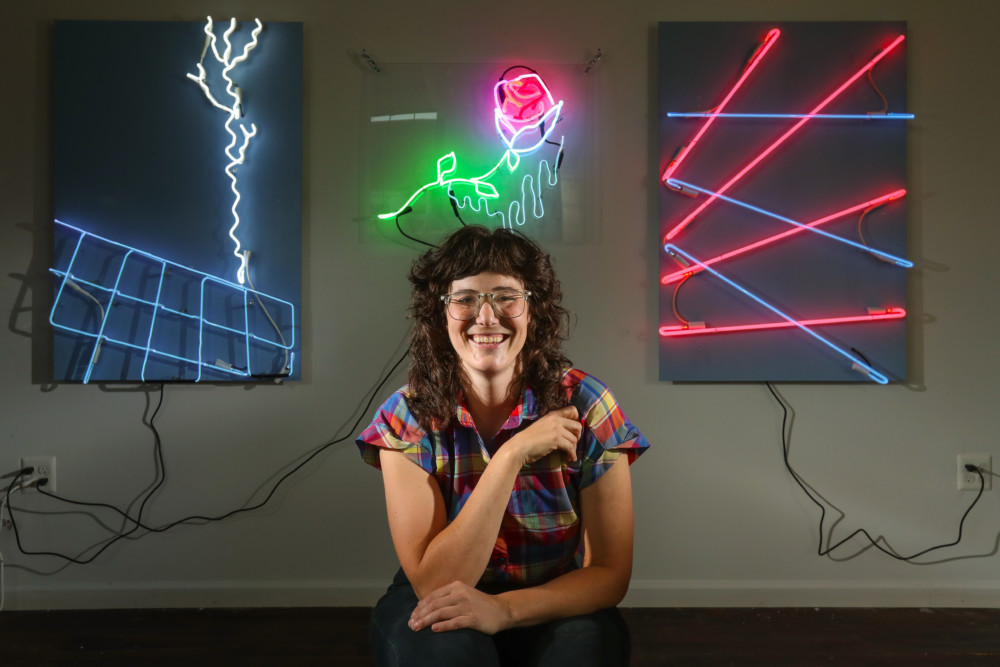By Anna Orso
The Philadelphia Inquirer
WWR Article Summary (tl;dr) Alissa Eberle is curious, has a passion for learning and is deeply patient. All of those qualities served her well under the tutelage of a well-regarded sign maker who was willing to share his knowledge and help her get her start in a rather unique field, neon sign making.
The Philadelphia Inquirer
Alissa Eberle begged to work for free. A transplant to Philadelphia, the artist, who hardly knew how to use a drill but desperately wanted to create neon signs for a living, walked into Urban Neon in Delaware County in 2012 and asked to learn from one of the region’s most prominent sign-makers.
Owner Domenic Urbani, one of just a handful of neon benders left in the area, told her no, he wouldn’t allow someone to work in his shop for free. But he’d hire her as a full-time sign fabricator, and when she clocked out each night, he’d teach her the ins and outs of the science-heavy, technically complicated craft that largely died out after its 1950s heyday but has experienced a resurgence in the last decade as an art form.
Eberle, in her early 30s and the only woman working in a part of the shop that was entirely men, spent the first year wondering if she’d ever be able to finish a project.
Urbani was patient, and Eberle kept trying.
It paid off. Eberle, now 38, is unveiling “Already Dreamed,” her first-ever neon art show, a collection of nine pieces that conjure deja vu and nostalgia, dreams and memories. The show opens Oct. 4 at Juggernaut Studios and GlassHaus, a glass shop launching at 3525 I St., Philadelphia, Pa., and runs through Nov. 4.
Her biggest fan won’t be there. In July, Urbani died at age 58 from cardiac disease, leaving behind Urban Neon to his wife, Betty, and their three sons who work in the shop. Eberle is now learning to bend in a world without the mentor for which none of her work would be possible.
“I don’t have a story of doing neon without him,” she said.
Urbani’s wife said she can’t overstate how proud “Dom” would have been of the woman 20 years his junior who had a shared passion for a technique unknown to most of the world. She said neon was everything to him, “and he was so happy to have this person that wanted to learn.”
In an interview in August 2018, Urbani said passing on the trade of bending neon, even in all its finickiness, was somehow therapeutic. “I love teaching,” he said. “I’m really lucky to be able to do this.”
But training another person to bend neon could be considered an art form in itself. Just making a single sign is a complicated process of creating a pattern, bending the glass by heating it over open flames and meticulously turning it, welding pieces together, vacuuming out the air and pumping it with a cocktail of gases, wiring it for electricity, creating backings and installing the piece. Not to mention that makers must have a deep knowledge of chemistry, knowing what gas mixtures will yield which colors.
The process is a malleable one depending on variables ranging from product purity to shop conditions. Eberle said she remembers asking something as simple as how long to heat the glass for, every neon bender told her “until it’s done.”
Unlike microwaving lunch, you can’t heat a piece of glass for 30 seconds the same way every time. Glass must be heated evenly, and skilled benders recognize when the glass is drooping and know to move the piece, a constant learning process that requires multiple senses, a skilled neon bender can smell when something is off, and years of training to master.
“I tell other people who do neon,” Eberle said, “if you knew how hard it was when you started, you might not learn. I think I love that about it.”
In the first few years, she was always fighting the urge to throw glass against the wall, assuming she’d never finish any piece, that there would never be a time when she’d be good enough to recognize what she’d done wrong, correct it, and not screw up anything else in the process.
Urbani seemed to know when Eberle was in her darkest place, often telling her when she seemed down to “pump” the glass he’d just bent without worrying she’d ruin it. It was an unspoken vote of confidence.
Since those first few difficult years, Eberle has assisted on and created countless neon works. Among the nine she’s showing this month is a colorfully flickering rose and a three-dimensional version of the iconic crisscross laser pattern that was a backdrop for too many nineties-style portraits. She’s made commercial logos and deeply metaphorical works and a sign that says “BYOB steak.”
Eberle often asked Urbani how she could ever repay him for the hours he spent in the shop, patiently working with her to achieve greatness in something so few can. He always said “just train somebody else someday.”
Over the last few months, a coworker at Urban Neon has been practicing with Eberle after work, asking questions with the hopes of one day learning the craft himself.
And early next year, after it finishes hosting Eberle’s first neon show, Juggernaut Studios plans to offer open neon bending classes.
This time, Eberle’s doing the teaching.
___
Distributed by Tribune Content Agency, LLC.














































































































































































































































































































































































